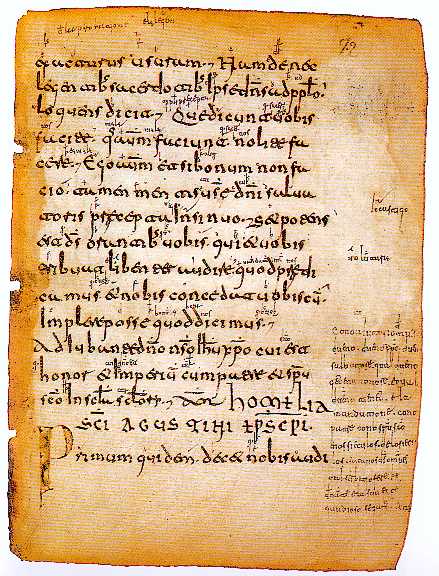
 |
Freethought & Rationalism ArchiveThe archives are read only. |
|
|
#1 |
|
Regular Member
Join Date: Jan 2008
Location: Myjava, Slovakia
Posts: 384
|
Hi, I am writing article, and I would like to decorate it with image of manuscript with marginal note, as representation of textual corruption (when marginal note becomes part of text). Doesn't someone have any picture i could use? Thanks.
|
|
|
|
|
#2 |
|
Contributor
Join Date: Mar 2006
Location: Falls Creek, Oz.
Posts: 11,192
|

|
|
|
|
|
#3 |
|
Regular Member
Join Date: Jan 2008
Location: Myjava, Slovakia
Posts: 384
|
Thank you
|
|
|
|
|
#4 |
|
Veteran Member
Join Date: May 2002
Location: oz
Posts: 1,848
|
|
|
|
|
|
#5 |
|
Veteran Member
Join Date: Apr 2002
Location: N/A
Posts: 4,370
|
Most manuscripts have some kind of marginal notes in them somewhere. They all have wide margins, you see, and the temptation to scribble is sooner or later overwhelming.
|
|
|
|
|
#6 | |
|
Veteran Member
Join Date: Jan 2005
Location: USA
Posts: 1,307
|
Quote:
Stephen |
|
|
|
|
|
#7 | |
|
Regular Member
Join Date: Jan 2008
Location: Myjava, Slovakia
Posts: 384
|
Quote:
Roger Pearse: Do you suggest that even scrolls which were scribed with wide margin, but nothing in them, got later something written in the margins? (Please correct me if I understood you wrong). If so, can you please back it up with some "reference", so I could repeat this claim in my article? Thanks. |
|
|
|
|
|
#8 | |
|
Veteran Member
Join Date: Apr 2002
Location: N/A
Posts: 4,370
|
Quote:
I don't have a reference. I've handled a certain number of medieval manuscripts, and that is my experience of them. I was thinking entirely of later notes, rather than notes added as part of producing the book. Just looking at the mss I have online myself, and staring at the page of the whole ms and looking for pages with marginalia: Here is an image from a 15th century Balliol ms. 79. with notes produced at the time of writing; most of the pages seem to have marginalia of that kind. From another 15th century msCodex Cusanus 42, I find a page with scribbling in the margin here. Another ms, Rome, S. Isidore 1/29, possibly 10th century, possibly 15th, has some marginalia on folio 15v. Even ms 30 at the monastery of Seitenstetten, which looks as fresh as the day it was made, (probably because getting to Seitenstetten is quite a journey!) on f.246v has a note at the foot of the page. That one looks like the same hand as the scribe, tho. Note the wide margins in all these mss. (all of Tertullian's Apologeticum). Moving to other online images, if we look at a Bodleian ms of the gospels, f.29v has a note on it. That lot, off the top of my head. How many of those notes are liable to be misunderstood and inserted I cannot say. Do say if I haven't been clear on this! All the best, Roger Pearse |
|
|
|
|
|
#9 |
|
Regular Member
Join Date: Jan 2008
Location: Myjava, Slovakia
Posts: 384
|
Roger: Thank you, you've been mostly helpful, more than I expected.
|
|
|
|
|
#10 | ||
|
Veteran Member
Join Date: Jan 2005
Location: USA
Posts: 1,307
|
Quote:
By the middle ages, the original ink of Vaticanus had faded so a medieval scribe "reinforced" the manuscript by carefully tracing over the faded letters. Usually, this reinforcer made no changes to the text but occasionally he would not not retrace the letters he wanted to delete. In this case, he only traced over the first and fourth through seventh letters of φανερων like this: φανερων, effectively deleting two letters to make Vaticanus agree with the standard text of Heb 1:3b. A later hand, however, castigated the reinforcer for this decision, re-inked the alpha and nu, the remaining two letters of φανερων, and penned the little margin note. Stephen |
||
|
|
| Thread Tools | Search this Thread |
|